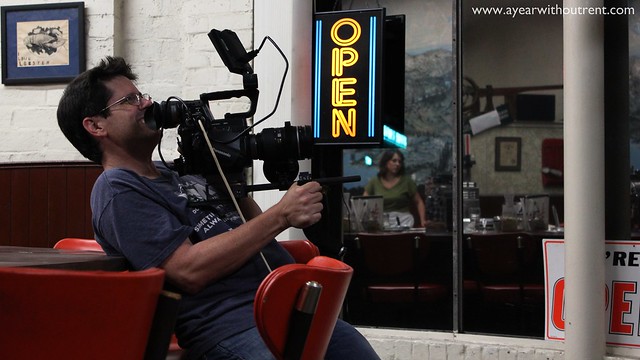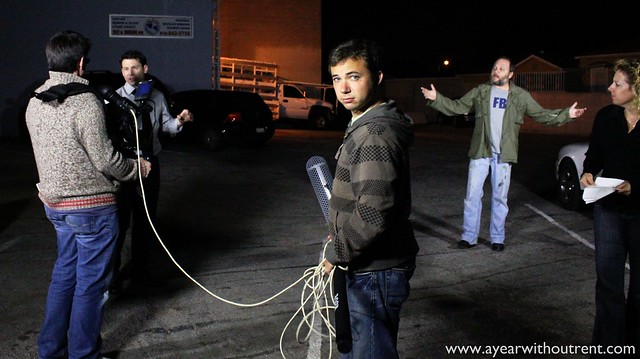by
Karen Worden
Editor's Note: Obviously, I cannot be everywhere at once. With that in mind, I've started reaching out to fellow members of the film community who might be interested in bringing the AYWR experience to a film shoot near them. Up first: Film Courage's very own Karen Worden. Enjoy. - Lucas
A couple of our friends launched a Kickstarter campaign in May for a short film entitled The Terrain. It’s almost every day that people we know (and many more that we do not know) reach out to us for help with their crowd-funding campaigns. (You can get word out about your project through
FilmCourage.com by submitting an article to us. Email us for info).
You can imagine our surprise when we heard about THE TERRAIN
Kickstarter campaign through the gossip grapevine after they had eclipsed their $2500 goal. We’ve known Brian Durkin and Todd Cattell on a personal level for years, yet they did not press us for assistance.
After we discovered the link, Brian, Todd, and producers Vivian Lee and Matthew Blanco had already exceed their goal in the first few days. The train was in the station and those who wanted to ride could get on if they wanted.
Long story short,
THE TERRAIN not only met its goal, it kicked its goal’s behind raising $7,310 in 30 days, exceeding the initial $2,500 goal. THE TERRAIN is a narrative short film written by Brian Durkin, starring Todd Cattell and Marisa Petroro, about two friends and fellow soldiers who return from war, broken and vulnerable, recruited into a covert Los Angeles assignment.
Flash forward a month. I receive a new camera. Being thoroughly inspired by (i.e., copying) Lucas McNelly’s ‘
A Year Without Rent’ campaign and its accompanying pictures, I wanted to take set photos.
I e-mailed director Brian shortly after getting the camera, inquiring if he needed a volunteer set photographer. He thankfully obliged and after several e-mail correspondences sent me a very organized call sheet. Eavesdropping on Lucas a few weekends ago, he mentioned to a group of listeners that an organized call sheet is sign of a great production. Even better when it mentions the weather report.
I had trouble sleeping the night before the first shoot. Yes, I was just a ‘volunteer,’ but what if I forgot the camera battery? What if the photos were not usable? Being a person who rarely gets a good night sleep, I tossed and turned on one of those hot June nights where terrors were hard to fend off.
When the alarm sounded a few hours later, I wasn’t quite in the mood to be social, let alone take set photos. But David prompted me to get going, and after downing some strong coffee, we drove to the shoot location (a little late and slightly ornery).
As we pulled up to the set location, the shoot was already in progress. I hate being late to things. Putting my ego aside, I readied the camera. This was my first shot as I quietly made my way to the set, shoot in progress.
 Day One: Exterior shots of The Terrain
Day One: Exterior shots of The Terrain
 Day One: Exterior shots of The Terrain
Day One: Exterior shots of The Terrain
The neighborhood was a mixture of cute little houses, one with so much ‘stuff’ in the front yard that someone on set affectionately referred to it as the "Sanford and Son" house. Another house across the street had a bunch of cute kittens and their mother cat in the yard. Cute cats in the yard always make me feel at home.
While on set things flowed so well that I didn’t have time to be nervous or tired. The producer, Vivian Lee, walked by and I snapped a quick photo of her on the way to replenish some essential set supplies.
 Day One: The Terrain producer, Vivian Lee
Day One: The Terrain producer, Vivian Lee
Inside I watched actors Sarena Khan (as Neda) and Brian Burnett (as Reza) take their cues from director Brian Durkin. The day called for a mixture of interior and exterior shots, with production halting momentarily for a blaring car stereo and car alarm.

 Day One: Actors Sarena Khan and Brian Burnett
Day One: Actors Sarena Khan and Brian Burnett
DP Casey Feldt always amazed me how he prepared for shots and (at times) was able to balance a cigarette in his mouth. He seemed to know instinctively which angles he wanted.
 Day One: DP Casey Feldt
Day One: DP Casey Feldt
For day two of the shoot on the Terrain, David and I drove from our radio show (right after our interview) with director Leonard Zelig, producer Roberto Alcazar and crew of SubHysteria, not even grabbing lunch. THE TERRAIN's second day of shooting took place at an old warehouse in Downtown Los Angeles.
The warehouse was intriguing, dusty and a little scary. Many rooms and enclaves inside this old ammunition storage facility just didn’t ‘feel’ right. The energy was off. However, the energy on set was great, although we were under time pressure to wrap at 5:00 p.m. sharp. The building manager would arrive at the property to lock up or tack on the appropriate billing for extra time. It was now 3:00 p.m. Things were rolling fast. Air conditioning was non-existent and we were well in the midst of an L.A. summer.
 Day Two: The Terrain interior warehouse shots as actor Todd Cattell
Day Two: The Terrain interior warehouse shots as actor Todd Cattell
readies his aim
My brief time on ‘Day Two’ of THE TERRAIN went by fast and furious, but shots were made. Although hurried, we made shots were made just in time. As the building manager arrived to lock up a few minutes before 5:00 p.m. he told us about the spirits and ghosts which befriended him at night inside the warehouse. He explained that most of the entities were friendly and called him by name, asking questions about ‘who was that guy here today?’ He seemed at ease while he told this story. Whether true or not, I didn’t care. It fit perfectly into the day and I didn’t want to ruin this experience.
 Day Two: The Terrain interior warehouse shots as rock star PA Kyle Kao surveys the shot
Day Two: The Terrain interior warehouse shots as rock star PA Kyle Kao surveys the shot
Director Brian Durkin and crew mentioned that they picked this warehouse especially knowing the exterior shots would receive little disruption from too much traffic. Unbeknownst to them, a movie/commercial shoot of some type was taking place on this Sunday afternoon just block away, rerouting traffic right by our location. So it was busy with cars whizzing by and slowing down to eye our exterior shoot. Funny how when a camera is out people can’t help but strain their necks to see if anyone famous is around.
 Day Two: The Terrain exterior shots, waiting for traffic in between scenes
Day Two: The Terrain exterior shots, waiting for traffic in between scenes
 Day Two: The Terrain exterior shot of warehouse as actor Todd Cattell (Major Jacob Kohl ) waits for his cue
Day Two: The Terrain exterior shot of warehouse as actor Todd Cattell (Major Jacob Kohl ) waits for his cue
 Day Two: The Terrain exterior as shots are checked
Day Two: The Terrain exterior as shots are checked
As I got back into the car at the end of the day, I felt empowered, satisfied with the photos I took, and happy that some great friends put together a first-class production. I watched first hand that you don’t need to wait for the phone to ring or an e-mail to validate your worth. You can make it happen on your own with proper planning, choosing the right people for your team, and taking the ‘Black Swan’ approach of not being too rigid at the risk stopping yourself in the process.
Karen Worden is a (very) part-time actress, co-host/co-producer of the Noon (Pacific) Sunday radio show Film Courage on LA Talk Radio.com, as well as co-owner of FilmCourage.com, along with husband David Branin. Each Sunday, Karen and David interview filmmakers and content creators from around the globe on surviving and thriving the entertainment industry. Karen, David and their three cats live in Los Angeles, California. Follow them both on www.FilmCourage.com, @FilmCourage, @DavidBranin and @KarenWorden.






















































